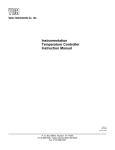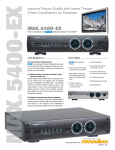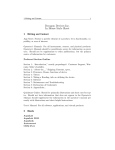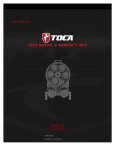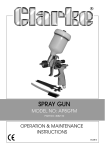Download service manual for analog controller models
Transcript
Analog Controller Page 1 SERVICE MANUAL FOR ANALOG CONTROLLER MODELS Information is reserved for trained, qualified technical personnel. It includes schematics & wiring diagrams. Any repair or service to a unit is to be performed by a certified technician ONLY. Attempting repairs outlined in this guide may result in voiding your warranty UNPLUG THE UNIT BEFORE SERVICING Models 611, 71, 911 TABLE OF CONTENTS Section 1. Troubleshooting Procedure Section 2. Field Calibration Check Section 3. Testing Temperature Probe Section 4. Replacing Control Board Section 5. Spare Parts List Section 6. Schematics & Wiring Diagram 1 Analog Controller Page 2 SECTION 1. TROUBLESHOOTING PROCEDURE Note: If the unit seems to function normally but fails to control or hold temperature steady, first perform instructions as in "Conditions and Steps before Troubleshooting the Unit" CONDITIONS AND STEPS BEFORE TROUBLESHOOTING THE UNIT 1. Set the HI/LO pump speed switch on the rear panel to HI. 2. Set up unit. a. For a closed loop application on the model 911 circulator, connect a 1/4 inch diameter or greater hose (a few feet long in length) to the Inlet and then Outlet. b. For the model 71 immersion circulator, clamp to the side of a bath container. 3. Use the same fluid and the same setpoint temperature as your application. Always use enough fluid to cover pump housing and heater. 4. Unit should visibly pump the fluid inside the reservoir. If not, check that the pump shaft spins freely and impeller(s) are in place. If bearings are worn out, replace the entire pump motor. 5. Check the fluid or fluid mixture: a. Watery consistancy, not thick like maple syrup. Viscosity <25 centistokes. b. Not boiling on the surface or freezing at the bottom of the reservoir or to the cooling coils. c. Not within 5°C of the freezing or boiling point of the fluid. 6. On the model 911, if used for an external application: a. Check the heat load does not exceed the rated cooling power of the refrigeration, or the external heat loss does not exceed the heater's 1000 watts. (Fluids within 40°C of their boiling point can cause so much heat loss as to require more than the 1000 watts of heat provided by the unit, especially in containers with a large open surface area.) b. Cover/uncover and add/remove insulation of both the internal reservoir and external application and tubing. Insulate the top of the fluid with hollow floating plastic or Teflon balls. PROBLEM #1 Unit does not heat or intermittent heat. Corrective Action a)Check power supply voltage shown on circuit board diagram. If low, check R8(and R9 on 240V units) for proper resistance. If still low or high, replace U1. If still low, check C1 for shorted or leaky condition. Also check R2 for proper resistance. b)Check all test voltages on the circuit board diagram. c)Check heater H1 resistance. 120V = 14.4ohms Ω, 240V = 58ohms Ω. d)Check continuity of and to heater H1 and triac Q1. e)Try replacing U1, Q1 or see Replacing Main Control Board. #2 Unit won't heat to set point. #3 Unit continuously heats. a)Measure for correct line voltage while the bath is heating. b)Check for DC voltage on the heater. If more than 30 VDC, replace triac Q1. Also check H1 heater resistance. a)Remove U1 IC and test again. If still heating, replace Q1. If stopped heating, Q1 is okay. Re-insert IC b)Check all test voltages on the circuit board diagram. c)Check if Q1 is properly heat sinked with heat sink compound. 2 Analog Controller #4 Unit does not pump. Page 3 a)Place rear speed switch in HI position. Unit should visibly pump the fluid inside of the reservoir. b)Check that the pump shaft spins freely and pump impeller(s) are in place. If bearings are worn out, replace entire pump motor. #5 Unit very slowly rises above the setpoint and won't come back down. a)Without refrigeration, the unit's pumping and stirring will generate heat. Check heat rise specification above room ambient. Try low pump speed, uncovering bath(s), removing insulation, use low viscosity fluid, add tap water cooling or a refrigeration unit. b)On model 911 turn cooling on. Set to 20°C. To check that refrigeration is working properly, feel for warm air exiting out of the rear vent. P1 or R6 are not making contact or are defective. #6 Controls only near 40°°C. See Field Calibration Check, section 2. #7 Setpoint knob inaccurate. SECTION 2. FIELD CALIBRATION CHECK There is no calibration adjustment or procedure. The setpoint dial accuracy of these units are rated to be within ± 10°C of NIST actual temperature over the entire temperature range. • Check calibration against a NIST traceable thermometer of known accuracy of ± 1°C or better. • Make sure the setpoint knob is mechanically centered across the dial range. • Check all test voltages on the circuit board diagram. • Check temperature probe as below. SECTION 3. TESTING TEMPERATURE PROBE Remove the probe wires from the board. Check that the resistance of the probe is within the tolerance shown on the schematic & wiring diagram on page 7. If okay, then check electrical readings from the probe metal sheath to the two probe leads on the following two items: • Check for any resistance reading. If there is any, the probe is defective. • On a digital voltmeter with an impedance of one megohm or more, check for any DC voltage present. If there is some, the probe is defective. SECTION 4. REPLACING MAIN CONTROL BOARD When removing/replacing the control board, always remove/replace the bath temperature probe included with the board. Temperature probes are checked at the factory to be within tolerance only when used with that board. HOW TO INSTALL A PC BOARD: To remove the existing PC board: • Unplug the unit from the power line. • Remove the two screws holding the cover in place. Once the cover is loose, disconnect the ground wire from the lug terminal. 3 Analog Controller • • • • • • Page 4 On a sheet of paper, note the colors and locations of the wires on the PC Board. Or use the wiring diagram on pg. 7.. Remove all wires from their terminal connectors on the PC board. Loosen the probe clip from its mounting bracket. Remove the knob insert, knob and nut holding the front heater control (potentiometer). Remove the three PC board mounting screws. Slide the probe up and away from the probe clip. To install the replacement PC board (Follow the steps above in reverse order): • • • • • • • • Slide the probe back into the probe clip. Install the three PC board mounting screws. Install the knob insert, knob and nut holding front heater control. Tighten probe clip into its mounting bracket. Attach all wires to terminal connectors according to your diagram. Attach the ground wire to the lug terminal. Attach the cover using two screws. Plug power line into unit. SECTION 5. SPARE PARTS LIST REF# DESCRIPTION PART# Q1 TRIAC,ISOLATED TAB,TECCOR,Q4015L5,15A,400V 200-058 M1 MOTOR,PUMP,MODEL 911,120V,SHAFT LENGTH 6-11/16 INCHES FROM MOUNTING SURFACE 215-235 M1 MOTOR,PUMP,MODEL 911,240V,SHAFT LENGTH 6-11/16 INCHES FROM MOUNTING SURFACE 215-236 M1 MOTOR,PUMP,MODEL 71,120V,SHAFT LENGTH 7-11/16 INCHES FROM MOUNTING SURFACE 215-237 M1 MOTOR,PUMP,MODEL 71,240V,SHAFT LENGTH 7-11/16 INCHES FROM MOUNTING SURFACE 215-238 PCB1 71-911 PC BOARD ASM.,WITH RTD PROBE,TESTED,120V 500-107 PCB1 71-911 PC BOARD ASM.,WITH RTD PROBE,TESTED,240V 500-108 H1 HEATER,TUBULAR,3 1/2" O.D. COIL,1KW,120V 215-067 H1 HEATER,TUBULAR,3 1/2" O.D. COIL,1KW,240V 215-068 NE1,NE2 LAMP,NEON,GREEN,RIGHT ANGLE,120V 215-161 NE1,NE2 LAMP,NEON,GREEN,RIGHT ANGLE,240V 215-139 M2 FAN FOR REFRIGERATION,AXIAL,4" INCH DIAMETER,120V 215-296 M2 FAN FOR REFRIGERATION,AXIAL,4" INCH DIAMETER,240V 215-297 4 Analog Controller Page 5 TEMPERATURE PROBE,7" X 1/4" O.D.,RTD,1855 ohm Ω @ 0°C 200-078 CB1 CIRCUIT BREAKER,MAGNETIC,1-POLE,12A,120V 215-041 CB2 CIRCUIT BREAKER,MAGNETIC,2-POLE,15A,240V 215-157 SWITCH,GREEN INDICATOR,MAIN POWER OR COOLING POWER 235-026 OTP OTP SAFETY HYDRAULIC THERMOSTAT,IMMERSION,120V 215-122 OTP OTP SAFETY HYDRAULIC THERMOSTAT,IMMERSION,240V 215-167 SW3 SWITCH,SLIDE,FOR PUMP HIGH/LOW SPEED 235-008 S1 SW1,SW2 5 Analog Controller Page 6 SECTION 6. SCHEMATICS AND WIRING DIAGRAM Schematic - Circuit Board 6 Analog Controller Page 7 Schematic and Wiring Diagram - Electrical 7







